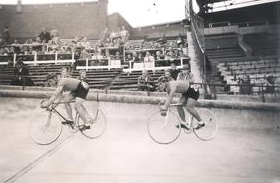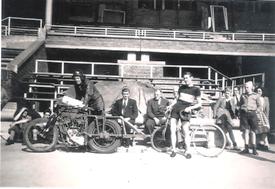1948 Amsterdam UCI World Track Championships: Exploring the images in Arthur Rice's photograph album by Geoff Waters
Posted: Tuesday 18th August 2020
In British cycling circles, 1948 remains indelibly associated with the shock defeat at the London Olympics of the reigning UCI amateur world sprint champion and national hero, Reg Harris, in the final of Olympic match sprint event. The surprise gold medal winner in two straight races against Harris on the historic Herne Hill track was the baby–faced 19 year old Italian sprinting prodigy, Mario Ghella.
The 1948 London Olympics was the first post–WWII Olympics, staged 12 years after the previous one, the tainted Berlin Games of 1936. The London cycling events were held in early August. Two weeks later the 1948 UCI world track championships were contested in Amsterdam in the Netherlands. The venue was that city’s multi–purpose 1928 Olympic stadium (see image below) which incorporated both an athletics track and a cycling track, with an infield accommodating a football pitch. The cycling track was thus in the region of 500 to 550 metres per lap in length but sufficiently banked to accommodate high speed motor paced events. It was at this venue that the British pairing of Jack Sibbit and Ernie Chambers had won a silver medal in the tandem match sprint event at the 1928 Olympics, finishing second to the Dutch partnership of Leene and Van Dijk.
Arthur Rice (1), a young South African cycling enthusiast, attended the 1948 world championships in Amsterdam and took a series of images of a number of leading competitors which he subsequently mounted in a family photograph album. This album was recently kindly loaned to me by his daughter, Lynne Larsen. The album’s images either have only the riders’ names inserted underneath or are untitled. What stories lie behind these images? This article explores these.
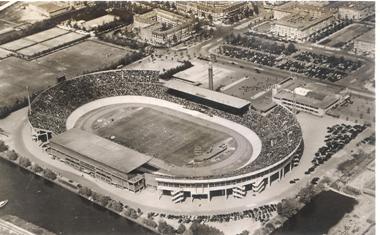
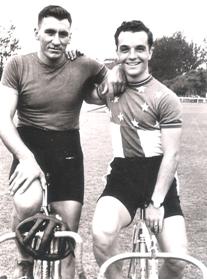
The 1948 South African connection (2)
A team of three South African track cyclists consisting of Wally Rivers, George Estman and Dirk Binneman competed in the 1948 London Olympics but none succeeded in winning a medal in any of the four track events contested: the match sprint (won by Ghella), the 1000 metres individual TT (winner: Dupont of France), the tandem match sprint (winners Teruzzi and Peroni of Italy) and the 4000 metres team TT (winners: France).
Left: Olympians George Estman (SA) and Jack Heid (USA). Heid finished 5th in the Olympic sprint and 7th in the 1000m individual TT at the 1948 Games
Additionally, in 1948 an official South African team was entered for the UCI world track championships for the first time. This Amsterdam team consisted of three riders none of whom had competed at the Olympics, namely J.J Brand, C. Olivier and E. Scholtz. However, like their Olympic counterparts none were to figure in the final results.
Quite how Arthur Rice came to attend the 1948 worlds and in what capacity is not clear but, as the images show, he had access to the infield area of the Amsterdam track.
Five UCI world track titles were contested in Amsterdam in 1948:
- Professional match sprint: 1947 winner Scherens (Bel)
- Amateur match sprint: 1947 winner Harris (GB)
- 5,000 metres professional individual pursuit: 1947 winner Coppi (I)
- 4,000 metres amateur individual pursuit: 1947 winner Benfenati (I)
- Professional motor paced: 1947 winner Lesueur (Fr)
The professional and amateur individual pursuit world titles had first been introduced by the UCI only two years earlier in 1946 while the amateur motor paced event had been dropped back in 1920 but was to be subsequently reintroduced in 1958.
The Arthur Rice images
There are eleven images in the album, as follows:
Images 1&2: Arie Van Vliet (Holland)
In 1948, Arie Van Vliet was 32 years of age. He had first sprung to prominence as a match sprinter during the 1930s. At the 1936 Berlin Olympics he finished second to Toni Merkens in the match sprint after a controversial decision went against him, but he won Olympic gold in the 1000 metres individual time trial. Later in 1936 he won the UCI world amateur sprint championship. In 1937 he turned professional and in 1938 won the world pro match sprint title, dethroning the long–standing champion Jef Scherens of Belgium. WWII intervened but he resumed racing thereafter. At the 1948 Amsterdam world’s he was the home favourite to win the pro world match sprint title which had eluded him since the end of WWII. He duly obliged, beating Louis Gerardin of France in the final.
Image 3: Reg Harris (Great Britain)
In 1948, Reg Harris was 28 years of age. He had sensationally won the 1947 UCI world amateur match sprint title at the Parc des Princes stadium in Paris, beating the Dutchman Cor Bijster in the final. This made him the home favourite to win the 1948 Olympic match sprint title at London’s Herne Hill. Instead the title went to the young Italian, Mario Ghella. Harris thus came to the 1948 Amsterdam worlds as the defending amateur match sprint champion and still smarting over his Olympic defeat.
Image 4: Adrie Voorting (Holland)
In 1948 Voorting was a promising 17-year old amateur match sprinter who was a challenger to the top amateur sprinters of the day. He was one of a new post–war generation of cyclists.
Image 5: Jan Hijzelendoorn (Holland)
Like Voorting, Hijzelendoorn (pronounced ‘Hay–zelen–dawn’) was an amateur match sprinter who challenged the top amateur sprinters of his day. In 1948 he was 19 years old.
Image 6: Mario Ghella (Italy)
The 19-year old arrived in Amsterdam fresh from his surprise Olympic victory over Harris. He was thus one of the favourites to win the 1948 UCI world amateur match sprint title.
Image 7: Réné Faye (France)
The suave 25 year old French amateur sprinter was defeated by Harris in the 1947 quarter final of the match sprint world title race in Paris. At the 1948 Olympics, in the tandem event the team of Harris and Bannister beat the French pairing of Faye and Dron in the semi–final on their way to the final in which they won the silver medal. Faye and Dron took the bronze medal. The gold went to Teruzzi and Peroni of Italy.
Image 8: Axel Schandorff (Denmark)
The top Danish amateur match sprinter, Schandorff was beaten by Harris in the semi–final of the 1947 world amateur match sprint in Paris on his way to his first world title. At the 1948 Olympics Schandorff, then aged 22, finished third in the match sprint behind Ghella and Harris. He also contested the 1948 Olympic 1000 metres individual TT title, finishing fifth (in 1 min 15.5 secs) behind the winner Jacques Dupont (Fr) whose time was 1min. 13.5 secs. (Tommy Godwin of Britain was third in 1 min 15.0 secs with Pierre Nihant of Belgium second in 1 min 14.5 secs).
Image 9: Ghella and Bevilacqua
Antonio ‘Toni’ Bevilacqua (Italy) finished third in the 1948 5000m pro pursuit championship behind the winner Schulte (Hol) and Coppi.
Image 10: Bontekoe and Ghella
Gerrit Bontekoe (Nederlands) leads Mario Ghella in a round of the amateur sprint. Bontekoe was an 8-times national champion, participated in three worlds and the 1948 London Olympics.
(This information is supplied courtesy of Marten Gerritsen from the Netherlands).
Image 11: Motor paced equipment
This image is untitled but clearly is of a pacing motorcycle and ‘demi–fond’ bicycle with reverse forks and small front wheel. It would have been used in the professional event.
Three notable points to emerge from these images are:
- The marked absence of spectators on the stadium’s tribunes in the background of most of the images. This is in contrast to the large crowds that thronged Herne Hill for the cycling events at the London Olympics. For the riders involved in both, Amsterdam must have been an anticlimax even if the evening semi–finals and finals attracted more spectators. It casts doubt on the organisational ability of the UCI at the time. Subsequent UCI world track championships at Leicester, UK in 1970 and Liege, Belgium in 1975 were similarly poorly attended, suggesting a persistent failure of the UCI to address this issue.
- The varied modes of dress of the competitors. Ghella wears a ‘modern’ close fitting track suit emblazoned with the word ‘Italia’; Harris wears a dressing gown which was the typical dress code of pre–WWII British trackmen; Van Vliet and Scharndorff both favour baggy track suit bottoms; Faye and Voorting sport elegant long trousers; and Hijzelendoorn wears plus fours. This lack of uniformity points to the absence of a common international cycling dress culture at the time.
- That it was the amateur match sprinters who were Arthur Rice’s main focus of attention at these championships.
The 1948 UCI world amateur match sprint championship
Having thus identified the dramatis personae in these images as being involved primarily in the amateur sprint event, how then did matters play themselves out on the track between these different national representatives? In his autobiography, the defending world champion Reg Harris describes these from his point of view as follows:
‘The 1948 world championships were held in Amsterdam only about a fortnight after the Olympics. As my body was still in pretty poor shape from the various batterings it had suffered, I was scarcely looking forward to the prospect of trying to defend my title. I no longer felt much pain, but I knew that my stamina was at a far lower level than usual and so the news I received on arriving in Amsterdam came as a bitter blow. The U.C.I. had decided that all the amateur sprint races must be condensed from two days into one. The only way in which this could be done was to have races going on from early in the morning until late at night, and nothing could have been more disastrous for me than that.
On the day, I found that I was getting on quite well at first; but by the time I reached the semi–finals I had done a lot of racing and I knew my reserves of energy were by no means unlimited. I was up against the wiley (sic) Schandorff, and his was a name that never caused me to lose any sleep. But at that moment I really felt that the thing I needed most of all in the world was a good sleep, and since I could not have one I was in trouble. Despite this pessimism, I defeated Schandorff in the first round of the semi–finals which boosted my morale. But when I wanted to use maximum effort in the second round, the strength just was not there and I lost. I gave the decider everything I had got with the result that it was declared a photo finish.
When the photograph was quickly examined, it was discovered that the light had been so bad that it was impossible to tell from it who had won. The judges’ only course of action was to call it a dead heat and call for another decider to be run…I knew that I could not find the necessary strength to put up a good performance again, and I suppose I was quite lucky that I only lost by half a wheel. The final result of that year’s championship was that Ghella won the title with Schandorff second, myself third and Bannister in fourth place. I returned to England feeling utterly miserable. I really expected my luck to change for the better at this point.’ (Reg Harris, Two Wheels to the Top, 1976: 76–77)
Thus Mario Ghella emerged as clearly the dominant international amateur sprinter of 1948, winning both the Olympic and UCI world amateur match sprint titles in that year against strong opposition. In February1949 he toured South Africa and raced at a variety of track meetings in different cities. He subsequently turned professional. Reg Harris mentions Ghella only once more in his autobiography, describing how he eliminated his 1948 nemesis in a four–up repêchage at the 1951 world professional match sprint championship at the Vigorelli stadium in Milan. Harris went on to win the 1951 title, making it his third successive pro world championship victory. He was to win it for a fourth time in 1954. However, there is no record of Ghella winning at international level subsequently. Instead Antonio Maspes became Harris’ chief Italian rival in the professional sprinting ranks during the 1950s.
All the 1948 UCI world championship results
| Event | First | Second | Third |
| Amateur match sprint | M. Ghella (I) | A. Schandorff (Den) | R. Harris (GB)* |
| Pro match sprint | A. Van Vliet (Hol) | L. Gerardin (Fr) | G. Senffleben (Fr) |
| Amateur pursuit (4000m) | G. Messina (I) | J. Duprat (Fr) | C. Coste (Fr) |
| Pro pursuit (5000m) | G. Schulte (Hol) | F. Coppi (I)* | A. Bevilacqua (I) |
| Motor paced | J– J Lambolay (Fr) | E. Frosio (I) | A. Mueleman (Bel) |
*1947 world champion in this discipline
The 1948 UCI world championships in Amsterdam were remarkable in that not one of the 1947 title winners of the five championship events succeeded in defending their titles. The most surprising losers amongst these were undoubtedly Fausto Coppi in the 5000-metres pro pursuit and Reg Harris in the amateur match sprint.
By his high standards, 1948 was a poor year for the 29 year old Coppi. In that year his major victories were restricted to the spring classic, Milan–San Remo, the mountains title in the Giro d’Italia (won overall by Fiorenzo Magni) and the Tour of Lombardy in the autumn. In Amsterdam he was beaten for the pro pursuit title by the 32 year old Dutchman, Gerrit Schulte. Schulte was an established trackman who had won the Dutch pursuit title several times. However, he was better known as an accomplished six day rider, his last victory coming in the Antwerp six in 1960 when he was 44 years of age. The 1948 victory over Coppi was the only time he ever won a world title.
For Reg Harris it was his lack of international success as an amateur sprinter in 1948 which led directly to him turning professional for the 1949 season, the year in which he was to win his and Britain’s first ever UCI world professional title.
These, then, are the leading racing stories behind the images of the 1948 UCI world championships in Amsterdam quietly sequestered in Arthur Rice’s family photograph album. They are stories which deserve telling.
Notes
(1) Arthur Rice was born and raised in Barkly West near the diamond mining city of Kimberley in South Africa, which is situated in a region known as Griqualand West. To quote from a report of an interview he gave to the British cycling journalist, John Burns, in 1976:
‘He (Arthur Rice) rode on the track and road at provincial level and was an Empire Games trialist (in those halcyon days) in 1950.’
He subsequently became a provincial cycling team manager and racing official, ultimately qualifying as a South African Cycling Federation (SACF) ‘referee’ or ‘commissaire’.
In 1976 he was elected national president of the SACF which, in apartheid South Africa, controlled white competitive cycling. He served in this capacity until 1979. By that time South African cycle sport was internationally isolated, excluded from both the Olympics and the UCI/FIAC world championships and affiliated events because of apartheid in sport.
To serve as the SACF president then was to court controversy. As SACF president, Rice took as his central task that of achieving a rapprochement between the three main cycling bodies then in existence in South Africa: the white SACF, the black African SAAA&CA and the de jure non–racial but de facto predominantly Coloured SACA. By the end of his tenure as SACF president this goal had been partially achieved. However, some South African cyclists of colour resisted merging with the SACF and chose to remain independent. It was not until the total collapse of the apartheid state in the early 1990s that full racial integration was achieved in the sport and South African competitive cycling was readmitted into cycling’s ‘global village’ by the IOC and the UCI.
(2) Exclusively white South African teams were permitted to participate in 10 of the 11 Olympic Games held between 1908 (London) and 1960 (Rome) and all included cyclists. A South African team did not take part in Los Angeles 1932 for reasons of cost. After the 1960 Olympics, the IOC suspended South Africa’s participation in the Olympics because of apartheid sport. South Africa was only reinstated by the IOC in the early 1990s after the collapse of apartheid. A multiracial South African team which included cyclists participated in the Barcelona Games of 1992 and teams have continued to do so subsequently.
White South African teams which included cyclists were permitted to participate in five British Empire/Commonwealth Games between 1934 and 1958 after which South Africa left the British Commonwealth.
The SACF and thus white South African cyclists were refused affiliation to the UCI’s amateur world cycling body, the FIAC in 1970 on the grounds that the SACF did not conform to Article 3 of the FIAC Statutes and Internal Regulations which stated: ‘The FIAC allows no form of discrimination for political, racial or religious reasons, towards the National Federations, or their sportsmen or officials’.
References
To uncover the background to these images, a wide range of printed and internet sources were consulted. The following were of particular value:
Burns, J. (1976). South Africa…Where Now? Supplement sent to subscribers to International Cycle Sport (published in the UK by Kennedy Brothers).
Fotheringham, W. (2010). Cyclopedia:it’s all about the bike. London: Yellow Jersey Press.
Henderson, N.G. (1973). Cycling Classics, 1970-1972. London: Pelham.
Jowett, W. (1982). Centenary: 100 years of organised South African cycle racing. South Africa: SACF.
www.classiclightweights.co.uk (for articles on the history of match sprinting and South African cycling history)
Posted: Tuesday 18th August 2020
This article appears in the following categories.
Upcoming Events
Whether you are looking for a gentle social meet up, or a 100-mile ride browse the community’s upcoming events and plan your next weekend outing.
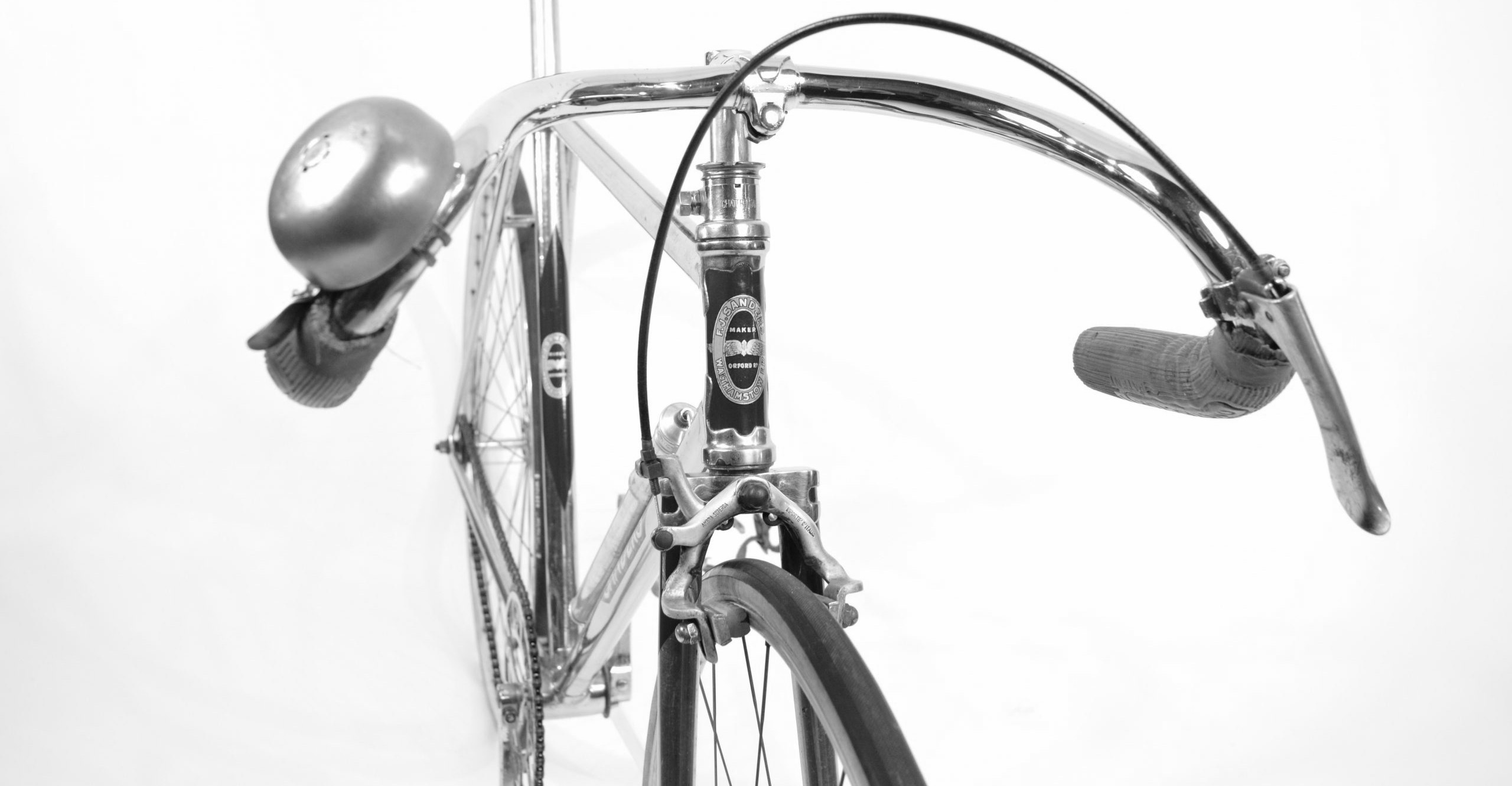
![1.Arie Van Vliet [Hol]](https://www.classiclightweights.co.uk/wp-content/uploads/2020/07/1948-worlds-waters-extras1.jpg)
![2.Arie Van Vliet [Hol]](https://www.classiclightweights.co.uk/wp-content/uploads/2020/07/1948-worlds-waters-extras2.jpg)
![3. Reg Harris [GB]](https://www.classiclightweights.co.uk/wp-content/uploads/2020/07/1948-worlds-waters-extras3.jpg)
![4. Adrie Voorting [Hol]](https://www.classiclightweights.co.uk/wp-content/uploads/2020/07/1948-worlds-waters-extras4.jpg)
![5.Jan Hijzelendoorn [Hol]](https://www.classiclightweights.co.uk/wp-content/uploads/2020/07/1948-worlds-waters-extras5.jpg)
![6.Mario Ghella [I]](https://www.classiclightweights.co.uk/wp-content/uploads/2020/07/1948-worlds-waters-extras6.jpg)
![7. Réné Faye [Fr]](https://www.classiclightweights.co.uk/wp-content/uploads/2020/07/1948-worlds-waters-extras7.jpg)
![8. Axel Schandorff [Den]](https://www.classiclightweights.co.uk/wp-content/uploads/2020/07/1948-worlds-waters-extras8.jpg)
![9.Ghella[left] and Bevilacqua[right]](https://www.classiclightweights.co.uk/wp-content/uploads/2020/07/1948-worlds-waters-extras9.jpg)
